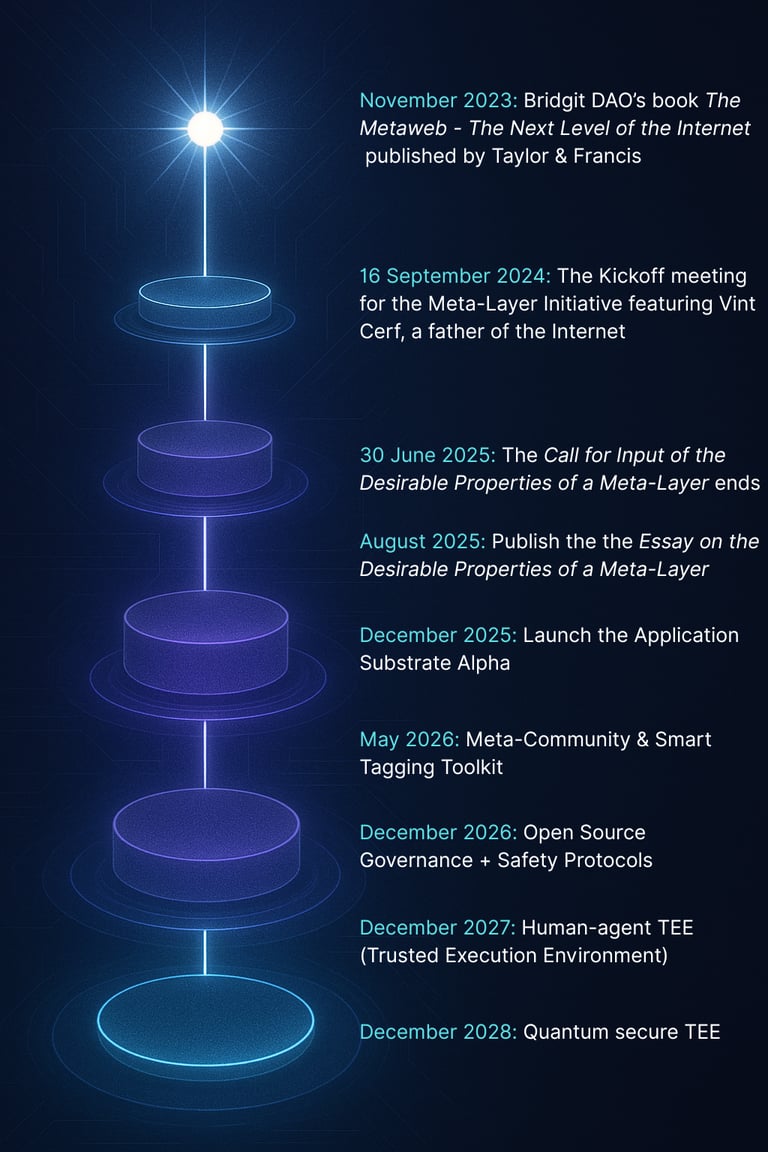Our Vision for the Meta-Layer
A roadmap for evolving the web beyond platforms—into something more open, intelligent, and human-centric.
This isn’t a product roadmap. It’s a collective blueprint—shaped by working groups, expert convenings, and community input. These milestones represent key inflection points as we move from concept to implementation, from idea to interaction.
🧠 From a Thought to a Movement
The Meta-Layer Initiative is rooted in a long-standing inquiry:
How can we reorganize the world’s knowledge to support collective intelligence & wisdom at scale?
This question began taking shape in the twilight of 2014–2015 in the mind of Shiftshapr, leading to what would eventually become Bridgit DAO. Inspired by the brain’s interconnected neural structure, the early vision focused on designing a web of knowledge that could help society respond intelligently to complex global challenges.
🔮 The Breakthrough: Seeing Above the Web
In 2017, while working on augmented reality book patents, the idea of a meta-layer above the webpage emerged—an overlay that could connect disparate online content in real time. This was further catalyzed by early explorations into blockchain technology, which revealed the potential for decentralized accountability and trust.
Despite early setbacks, momentum grew. A committed team began coalescing around the mission:
To transform how the world organizes, accesses, and interacts with information.
This journey culminated in the publication of
The Metaweb: The Next Level of the Internet by Bridgit DAO in 2024.
📘 The Metaweb Book: A Manifesto for the Next Web
The book laid out a bold claim:
There is a decentralized, AI-assisted public space above the webpage—waiting to be built.
It introduced the idea of the Metaweb: a multi-layered internet where the traditional web remains intact, but a new environment floats above it—supporting real-time context, collective intelligence, and accountable interaction.
The book proposed:
Verified identities
Dynamic annotation and tagging
AI containment frameworks
Community-owned knowledge and tools
“...the notion of a meta-environment above the webpage is directionally interesting. The book presents a creative argument that warrants further discussion.”
— Vint Cerf, one of the Fathers of the Internet
🧱From Vision to Implementation: The Meta-Layer Initiative
Following the book’s release, Bridgit DAO launched the Meta-Layer Initiative—a practical step toward building the substrate envisioned in The Metaweb. The goal:
Enable developers, communities, and participants to build directly above the web—through overlay apps, smart tags, and context-aware interactions.
🧭The Kickoff Meeting: September 16, 2024
The initiative began in earnest during a gathering of contributors, including Vint Cerf, who emphasized core principles for the Meta-Layer’s design:
Accountability
Participant agency
Simplicity
Interoperability and standards
Vint recommended an important first step:
Co-author an essay on the “Desirable Properties of a Meta-Layer."
The meeting also identified a pressing need for:
Real-world use cases
A framework for federated authentication
Early exploration of business and incentive models
🧬The First Deliverables: Anchoring the Initiative
The Meta-Layer working groups have since focused on:
A growing library of use cases
A structured effort to define the desirable properties of a meta-layer
A collaborative process to co-author the guiding essay
The groundwork for an application substrate for builders
🌐 The Meta-Layer: A Vision for a Better Web
The Meta-Layer Initiative is more than a tech project—it’s an evolutionary shift in how we experience and shape the internet.
It invites us to reclaim agency, embed trust, and create systems that work for humans—not just platforms or algorithms.
It builds on a belief shared by those who helped birth the internet:
That digital spaces can be open, accountable, and in service to the common good.
“It’s not about replacing the web. It’s about building up.”
~ Bridgit DAO
🌱 Origin of the Meta-Layer Initiative
✨A Shared Vision, Taking Shape
The Meta-Layer is not a single protocol or platform—it's a movement toward a more accountable, contextual, and human-centric internet. What began as a theory has now sparked working groups, prototypes, and a growing community of experts, technologists, and systems thinkers


🗣️Endorsements & Signals of Momentum
"I agree with the premise that accountability is an important consideration for the next iteration of the Web. While I have concerns around scalability and implementation, the notion of a meta-environment above the webpage is directionally interesting. Overall, the book presents a creative argument that warrants further discussion and exploration." ~Vint Cerf, One of the Fathers of the Internet & co-founder of the People-Centered Internet
"We are thrilled to welcome you into All Tech Is Human's mentoring program! Our delay in response stems from the fact that we received over 900 applications." ~ All Tech Is Human
"Your book blew me away. Thank you!" ~ Dr. Susan from the People Centered Internet
the book provides a solid response to the late Douglas Engelbart’s quest for the co-evolution of social and technological systems in the face of ever more complex and urgent global issues.” ~Jack Park, cofounder of Topic Quests


🧪 From Theory to Application
What if you could see who’s with you on the web—right now?
The Presence Browser prototype reimagines how we experience websites by allowing participants to reveal their presence and interact directly above any webpage. Built on early meta-layer principles, it enables real-time co-browsing, shared annotations, and context-aware conversations. Rather than browsing alone, participants can see who else is reading, thinking, or building—page by page.
This prototype marks a foundational step toward on-page presence, persistent identity, and shared digital space.


🌌The Meta-Layer Ethos
We believe...
The web should serve communities, not platforms
Identity should be sovereign, not siloed
AI should be transparent, not manipulative
Participation should be rewarded, not extracted
Context is a right, not a feature


🌀 Roadmap & Milestones
These milestones are not endpoints—they’re invitations. Every deliverable is an open challenge, every tool is a prototype for what’s to come.
If you’re a developer, researcher, community builder, or just web-curious… you belong in this process.


Contribute | Build | Participate
Join us to shape the future of the web.
Connect
© 2025. The Meta-Layer Initiative. All rights reserved.
Ecosystem
Bridgit DAO
Presence AI
Partners
Learn
About
What is a Meta-Layer
Meta-Layer Infra SIG
Join Us
Onchain
Digital Badge
FAQ
Glossary
Roadmap
Blog
